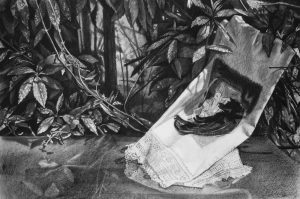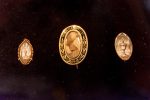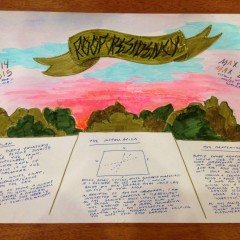I’ve been an admirer of Cindy’s art for a while now. Cindy is a painter and a maker, and whether she’s making a mural on a wall, an intimate work on paper, or an animated short video, her materials reflect the alchemical processes she uses – inks made from nuts, berries, flowers, plants – which add a part-medieval, part-survivalist, part-scientific, part-campfire girl atmosphere. The love of experimenting – messing with earthly matter and watching the results as one flower-petal experiment succeeds in making a beautiful ink and another, sadly, does not – that’s part of Cindy’s process. So is figuring out the why of those experimental results and doing historical research into her materials and the sites from which they were gathered.
To say Cindy’s studio is a laboratory is not quite right. But saying it is an art laboratory is saying it truly. For not only does the artist work with the natural materials she sources and transforms to create works on paper, but she also transforms the painted images on paper – of birds, moths, worms, squirrels – into lyrical and dancing “stars” of the short abstract, stop-action animations she makes. And these short videos – accompanied by meditative and atmospheric music created by a collaborating artist – are celebrations of the earthly that convey, with a whimsical touch, the awe and questioning that are hallmarks of great art.
Here below are excerpts from my conversation with Cindy, which took place in her studio in Kensington on Oct. 25 and was recorded and transcribed, the text edited for clarity.
Roberta: Cindy, you have a practice that involves making your own inks and dyes. It’s alchemical. What are you working on right now?
Multitasking stop-action animations and color poems
Cindy Stockton Moore: I am working on two major things–normally five things at once–but the two major things are the animations from my Art in the Open this past summer and a series of videos that I’m calling Chromopoems, looking at each color through dyes and inks, and making very short (one minute) experimental videos that bring the animation and the process of making the color together. The Art in the Open animations are these ones on the wall behind you. I did some on site. I set up this table that has a hole in it; those animations I shot directly on the ground (literally on the grass) during Art In the Open.
Roberta: What was it you were photographing when you were pointing your camera at the ground?
Cindy: It was little bits that I had painted – what I make is little animation bits. For Art in the Open, I made a palette of homemade charcoal ink, some goldenrod and then …what else did I find growing there? Oh, some pokeberry. So I made a palette and then painted specimens I found on-site. As I painted them, I would animate. I also took images and videos that [now] in the studio I’ve been able to make into longer animations – of a grackle who came to visit me or this squirrel. The squirrel is painted with acorns that I’ve got from the area and walnut ink.

Inks or dyes?
Roberta: You mean ink from acorns or walnuts? Do you call it ink or dye?
Cindy: Well, yes, they’re dye-based inks. If the dye gets strong enough, they work as inks.
Roberta: And what is the tool that you use when you’re making the drawings? A very fine hair brush?
Cindy: Not that fine – but it comes to a point. And those inks I made into pan color, so I could bring them with me on-site. Pan color? Think of watercolor sets–how the paint is dried in a pan–those little boxes are all pans.
Roberta: I see you’re using an Altoids box as your pan. Very clever!
Making charcoal in an Altoids box
Cindy: The Altoid box is really useful to hold the pans. It’s also really excellent for making charcoal. For the charcoal process, you need the heat to get to the sticks, but not the oxygen (you can’t have it crumble into ash). That container will preserve the sticks perfectly; you can put them inside and throw it into the fire. It’s not allowing them to be consumed by the fire, but it’ll make little sticks … little Altoid-box sized sticks of charcoal.
Working with invasive and non-native plants
Roberta: What kind of sticks for the charcoal?
Cindy: I like vines. I tend to choose vines that are “choking” out other vegetation, vines that should be removed. The traditional one is a grape vine, like a wild grape, but I tend not to mess with them unless they’re causing a tree distress. Other things like porcelain berry that are actively taking over in an environment, I feel pretty good about chopping down and reusing them.
Roberta: How do you know about porcelain berry? Are you a horticulturist?
Cindy: I am not at all, but I’m learning! So, that knowledge comes from all over. A while ago, I was writing for the Science Center (University City Science Center) and I covered this show about plant blindness, I would say, six or seven years ago when I realized “Oh, I have a lot of plant blindness. I can’t walk and identify things; I can’t see them.” One of the steps I took to remedy it was I became a weed warrior at Heinz (John Heinz National Wildlife Refuge at Tinicum). When I volunteer at Heinz, I learn so much from the other volunteers and the biologists there – just while going out and helping pull things that are damaging. It has been really helpful, and I’ve learned to identify things when I’m on my own walks. I don’t take anything from the national refuge to use, but the work that I do there informs how I can help other landscapes.
Roberta: And what is the problem with porcelain berry? Is it invasive?
Cindy: Yes, it is invasive and non-native.
Roberta: Non-native.
Cindy: I would put air quotes around both of those terms … I mean, well, we don’t call English ivy invasive. But in gardens it is invited. There’s politicizing with words like invasive, non-native. A lot of times those plants do well on distressed lands; they are doing a part, right?
Not a gardener growing up
Cindy: Growing up I puttered around a lot outside; a lot of fort building, but not a whole lot of gardening. My grandfather and great-grandfather had gardens, so I was always interested in it, but we never did. And now, we do garden a little upstairs [on the deck]. I grow some dye-producing flowers. I’m starting to get into that a little more, but it’s not a natural state for me.
Animation
Roberta: Earlier you mentioned video and animation. You create the inks or dyes on and then you paint on paper and create animations with the cut out images, and edit in Adobe Premiere or Photoshop.
Cindy: I can show you the [paintings] on the wall – this is in a very unfinished state. You can see the ground animation and then also what these things look like when they move. I’ve been working with landscape for a while, but to actually be able to make [the work] on site and to use things that I’ve found there to create it – it’s allowing me to interact with the landscape in a much more specific way. Here’s another example of what I did onsite – painting the mushrooms that I found in a little sample area. I tried to identify what was growing there and then move it.
Color poems
Cindy: These color poems are only a minute long [each]. I’ll show you the yellow one, it’s new, but eventually they’ll get sound. I work with a collaborator for that, Rachel Wetzel. These videos get really layered; some studio animation, and some studio experiments with color, and then some of the animation bits that I draw back into a stop-motion.
Roberta: Is that the ginkgo leaves that makes the yellow? Ginkgo leaves turn a vibrant yellow in the Fall and right now they are in abundance on the sidewalks of Philadelphia everywhere.
Cindy: No, the ginkgo does not make the color, but I love to paint them. I think that their bark would, but I haven’t gotten anything out of those leaves. They do hold their color well … . I’m wondering if I dried them and ground them? It’s possible. This [footage] here is from Dye Club, from the goldenrod. I’m taking some footage, layering some footage, to have the whole process of making the inks be part of the video-work.
Music by collaborator, Rachel Wetzel
Roberta: And where does the music come from? Is it a harp? Or mandolin?
Cindy: I think she is playing that on her electric guitar. Rachel Wetzel. She’s down in Baltimore, so we do all our collaboration remotely now. She’s wonderful. She’s also a leading historian for Robert Cornelius. Cornelius is an early Philadelphia photographer. Rachel is an artist, a musician, and an art historian. She does a great job. We have a lot of fun.
Roberta: The music goes very well with your animation.
The work/studio/life interaction – and balance
Roberta: You mentioned about getting back into the studio after working at a job, most recently with The Velocity Fund. How do jobs – plus family – impact your studio practice?
Cindy: I think my jobs do have an impact. Before The Velocity Fund, I was an adjunct professor at a number of places. It may have even started with a student question in a drawing class,” how is charcoal made?” and we were like…“well, like let’s find out.” Teaching digital studio components really opened up some new avenues into my own studio practice. I would say with Velocity Fund- the collaborative spirit of the projects and the responsiveness of the artists/grantees and even helping people with the application process – were all super inspiring. It is still inspiring, the way [grantees] are working, not as outside artists placing something in a space or with a community, but really responsively working from within – to hear what’s needed and to see how to do that.
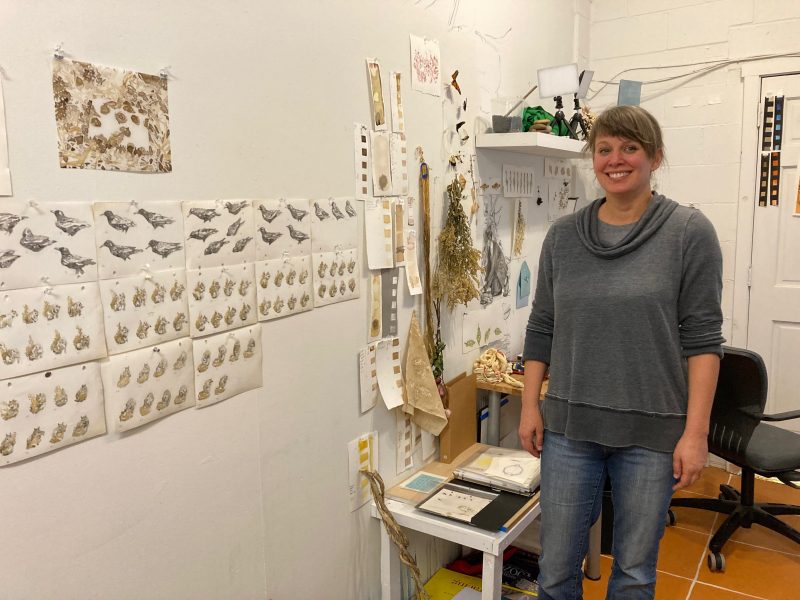
Grizzly Grizzly and Dye Club – finding your people to work with
Roberta: You mentioned you are part of a Dye Group. What’s the name of it?
Cindy: We just call it Dye Club. We don’t have a flashy name yet (both laugh).
Roberta: You were an early member of Grizzly Grizzly, one of the artist collaborative galleries that are in the 319 building. Talk about Grizzly Grizzly a little bit and about collaboration.
Cindy: I left (Grizzly) maybe about five years ago. But I was a long-time member and some of our collaborations had key people who I just love to work with. I’m going to find a way to be where they are at! Mary Smull was part of Grizzly Grizzly with me, and we were part of the CSA Art Philly together. Now, besides being close friends, (we walk twice a week,) we do Dye Club together. [Mary] and Kelly Cobb, who is from the textile/fibers world and teaches down at UDel – and Miriam Singer, a great artist who does screen-printing and is a member of Space1026; and Tamara Suber, who’s at UPenn, and is a shepherdess. Next Dye Club meeting, I think that Angela McQuillan might join us- she’s not only an amazing artist, but also has a background in chemistry. Everyone’s bringing their own set of questions to it, and we just have different experiments.
Roberta: I have to stop you at shepherdess. Does Tamara own sheep or what does this mean?
Cindy: Yes
Roberta: In the city?
Cindy: In the city – or just outside? We haven’t had time to visit the sheep yet, but we’re looking forward to it. That’s a whole new avenue. We’ve never tried to process wool or scour it. With Miriam we’re experimenting with screen printing the modifiers. So instead of printing with the inks, we print with things that change the dye, like iron or soda ash or alum. We can dye a piece of fabric and it’s still reactive because it’s a living process, and then screenprint on the modifiers. We can draw on Miriam’s background there, and then with having Mary taught repeat pattern design at MiCA, we just naturally came up with a design for a repeat pattern to do yardage.
Cindy: It’s very fun and families are welcome. We are all parents as well. So we’re also carving out a space where we can make things and the kids can come along.
Roberta: Kids love mess.
Cindy: Yes, the messes the kids make and the ones we make. And Mark helps out on those days (artist Mark Stockton, Cindy’s husband).
The Chemistry when the dyes react to modifiers
Roberta: You are combining chemicals from your dyes/inks and other matter you call modifiers and there might be more than one chemical reaction going on in the print itself.
Cindy: Yes, in the print itself. That’s what’s so wonderful about dye making or ink making; it’s so dependent on the place. The plant will be different, when you harvest it, how you process it. But then the modifiers are all different, as well. Sumac comes out this beautiful color – and it didn’t do anything if I added an acid (lemon) but with soda ash, it turns a totally different color, and with iron it turns a beautiful violet. The colors can just shift – that’s the modification, they change molecularly… . It’s pretty magic. So it’s a little bit of chemistry, a little bit of cooking, a little bit of gardening, drawing and painting.
Roberta: Talk about boiling versus steeping as ways to harvest the colors for the dyes. You said you failed to get color from one flower when you boiled it.
Cindy: The morning glories. I have some nice brown morning glory ink that doesn’t do much good. It can be a blue violet, blue or green. I was thinking I could use an InstantPot, and I got one from the thrift store, and it doesn’t work for making ink. But, some things you can boil, some things you could be a little rougher with than flowers (laughs).
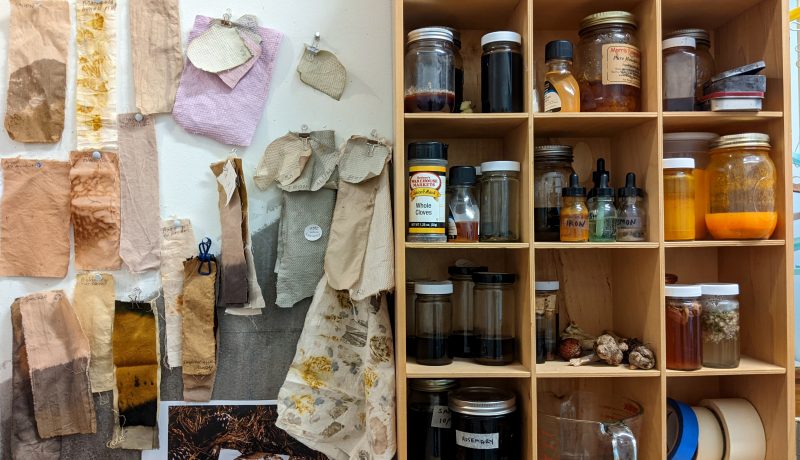
Sharing what she’s learned, loving to learn, sharing the art
Roberta: Do you have ambitions to teach this technique and process to young people? I hear an education subcurrent in all your work. You’re keeping meticulous sample books of the different experiments. Is there a goal or are you experimenting for the love of what you’re doing. And I’m not passing judgment!
Cindy: Yes, I think both. I’m loving the experiments, and they are going to go on as long as they can. But the way that I’m hoping to channel this year specifically, besides finishing the cycle of all the color videos, is to put all of this into book form. That is the goal – a book, and that would be collaborative in nature. I’m also hoping to tap into some sites in and around Philadelphia, because I think that’s my other love, and the link between my projects is the research. I’ve been to Winterthur’s library recently, looking at their old dye recipes. I want to put it all together–research, people and places– into a book. I think from there I can envision a future that would have workshops for different ages.
Roberta: It sounds marvelous. And I’m sorry to put it in that black-and-white, goal/non-goal context.
Cindy: No, I think it’s important to ask – “How are you gonna share it?” Even with Dye Club, it’s fun to learn and it’s doubly fun to learn with other people who are interested in doing that with you. Outside or inside academia, I think that teaching will be a part of it [for me] – because it is something I miss doing. So even if the institutional system wasn’t a good fit, there are other ways to learn together.
Local research institutions welcome artist researchers
Roberta: Let’s talk about the institutions like Winterthur, which has a dye library. That’s exciting. How about the Natural History Museum in Philly?
Cindy: The Academy (of Natural Sciences of Drexel University)? Yes. Actually the painting that I donated to the Artblog auction is from a specimen from the Academy’s collection. They have all kinds of specimens. What I love about theirs is that when you’re seeing a walnut specimen from 1930, it will tell you in handwriting where they collected it and when. You can even revisit that site and see the change, “Oh there probably wasn’t a Wawa here back in 1930.” (laughs) I would love to do more with them, as well. A lot of their collection is digitized as well, and at Winterthur it’s fun to go into the stacks and really dig in.
Roberta: You could dig in at Winterthur? Did you need a special permit for that?
Cindy: No, that’s what’s wonderful. These are some of the things I’m learning. I’ve found that libraries, like research institutions, want people to come and research. Accredited or not, you just sign up as an independent researcher and they let you in; they are happy to have you. And for artists especially, they have a call for Artists in Residence, so they are already open to the idea of working with artists. I’ll definitely apply; I would love to. It’s a really rich collection -and also the gardens there as well, have so much material.
Roberta: It’s a really quirky place.
Cindy: Yes, but even that’s interesting too because they have a chemical dye history associated with that family wealth source. I believe it was gunpowder. I think that – like so much of chemistry- there’s overlap. They accidentally find a dye when looking for a drug or they accidentally find cyanide when looking for a color. Accidents, that’s part of it.
Roberta: You’re absolutely right. Let’s get back to Dye Club. When do you meet again and how often.
Soil chromatography
Cindy: Not very regularly! We’ll meet probably twice this month because we’re getting the printing process up and running. Next time we might be up at Kelly’s house doing a dye pot and Angela may join because we’re all interested in soil chromatography. That’s a chemical process in which you can see the nutrients in soil that blossom into different colors. I’m working on a long term project through ecoartspace It’s a soil project dealing with remediation that I’m starting to develop ideas for. We thought it’d be a good experiment with Dye Club because soil is something I know even less about than plants. So there’s been a big learning curve there (laughs).
Roberta: What’s that beautiful blue and black painting on the wall there?
An abandoned painting gets a new use
Cindy: This painting is a painting that did not survive multiple interventions. I kept trying new things with it and eventually I abandoned it as a painting. So now it’s my bulletin board where I just pin things up. Maybe there will be something in there for me to pull out of it, but I think for now it’s just going to be an accumulated space. It’s a monument to my failure. It just never, never came out the other side.
Roberta: Well, it’s the most beautiful thing ever to not work. And I like the little drawings you have on top of it.
Cindy: Those are moths – that’s the nice thing about the animation, I have all these bits left over. So that’s from an earlier oak moth animation. I can take the moths and fly them around different environments now.
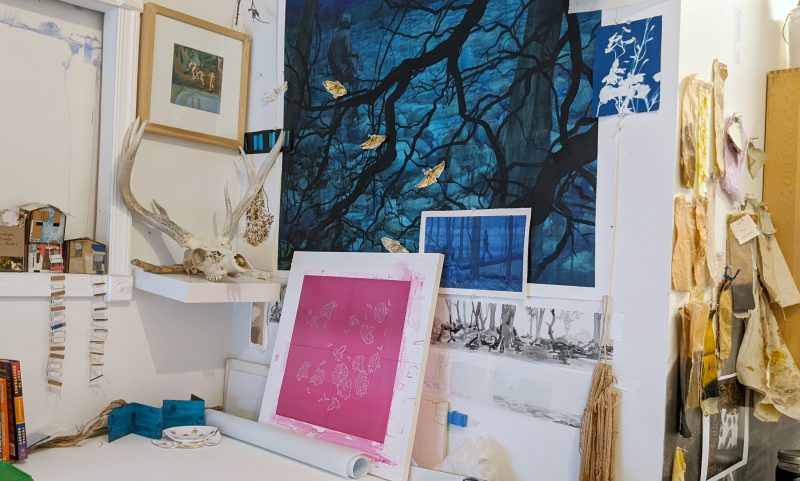
Flies on the wall, and butterflies
Roberta: Do you ever think of using butterfly wings to get the shiny iridescent colors?
Cindy: They won’t give you any color though! They’re beautiful. When I find the dead butterflies, I keep them and I pin them on my walls. Walking by the side of a highway, you actually find quite a few dead butterflies. The trucks will hit them and not even register it. But the flies on my wall, pinned to the wall like the butterflies, definitely did not meet a truck. I killed those flies (Both laugh).
Roberta: No soft spot in your heart for flies?
Cindy: Not the flies. We used to have frogs we fed them to, but now they’re my models. But butterflies, their pigment stays with them. Some bugs, traditionally, you can get very good color from.
Roberta: Like ladybugs?
Cindy: I don’t think you can get much from ladybugs, but….
Roberta: How about that invasive, that beautiful horrible invasive insect…
Cindy: Oh, the lantern fly. I haven’t really tried. That’s worth doing because you can definitely get a lot of them (both laugh). I should be able to do something with them.
Roberta: Yes, but you have to catch them.
Cindy: There’s a technique! There’s a water bottle technique – have you seen it? … if you go up behind them, they’ll jump right into it. So it’s like they vacuum themselves into the bottle. It’s pretty gratifying – you get a little “fwump.”
Weaving and dying and painting all together
Cindy: I should tell you about this thing too, yarn spools on wall. Mary Smull is a weaver so we are starting a loomed project collaboratively- where she will set up the weft(or the warp I can’t remember which, and then I can hand paint directly on it and then we’ll turn it into a weaving. I have never done that before, but I’m very excited to collaborate on actual textile work. With the modifier.It will be dyed and then I’ll paint on it – probably with some rust water. Rust water is good for an iron modifier – and it’s easy in Philadelphia to find rusty bits to make more of it. It’s a different kind of urban foraging. My kids know all about it, “Mom, there’s a rusty thing!” (Both laugh)
Roberta: Cindy, do you have a website where people can see more of what you’re doing?
Cindy: I don’t have any social media presence, but I do have a website.
Roberta: Thank you Cindy for having me in.
Cindy: Thank you, Roberta.



